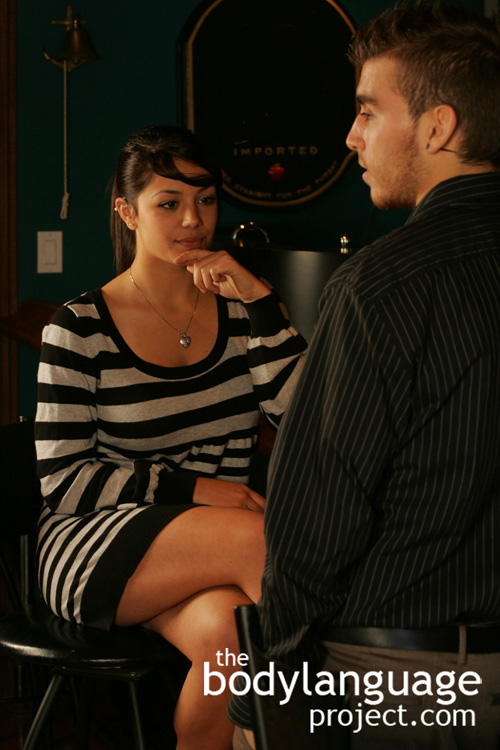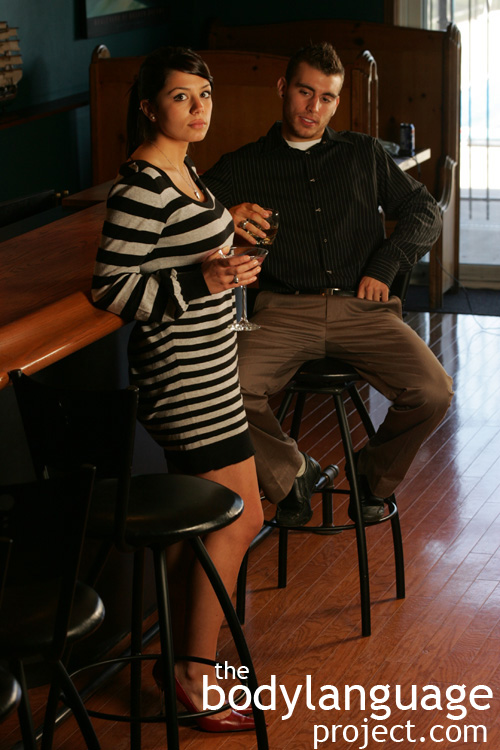Body Language of The Once Over
Synonym(s): Eye Assess, Undressing Her With His Eyes, Catty Eyes.
Description: A sexual or competitive eye pattern that follows the body over its entire form from the toes to the top of the head usually done by men on women (sexual interest) or by women on other women (competition – sexual). When men look women over, they will stop at the buttocks, breasts and face.
In One Sentence: The once over indicates a sexual interest or is meant to issue a combative challenge.
How To Use it: Men and women can both use the “once over” to signal to a partner that they find them appealing. Women should look men up and down pausing on the groin area or buttocks, shoulders and face. Eye contact should be made to anchor the message. A subtle lip lick will produce an unmistakable message. Men can also signal interest by making forays to the rest of the body. This should be done either covertly so as to create the impression of respect or, conversely, aggressively and with confidence to show high dominance in an unapologetic fashion. Mixing the two strategies will result in a poor impression – so choose one and use it wisely.
It should be noted that women generally, do not take well to the once over, at least at a conscious level. Subconsciously, women appreciate being desired. However, many times this is context specific. Being in a committed relationships can sometimes be a moral hindrance to being coveted, other times the once over “compliment” must come from a desirable potential suitor.
Women can also challenge other women by gazing them in a “once over” fashion to tell them that they “have problems.” Looking askance and performing the once over tells other women that they are on their hit list.
If men wish to intimidate and assault women, they may use the “once over” to metaphorically “undress them.” No good results will come from an unwelcome eye pattern, so be warned.
Context: a) Dating b) General/Business/Social.
Verbal Translation: a) “I’m looking you all over from your head to your toes stopping at your assets to measuring my interest in you.” [men on women and women on men] b) “I’m checking you out to see if you’re hotter than me and are going to be one of my direct competitors in the sexual marketplace.” [normally women on women]
Variant: Look under Eye Language (category) to see many ways the eyes convey hidden meaning.
Cue In Action: a) Dave and Mary carefully checked each other out over the course of the party so as to not appear overt and offensive. b) The new intern had arrived and Mary, the long time staff member knew full well that she would be trouble. Mary did the once-over on Katie and noticed that her skirt was too short and her cleavage was showing. Mary knew right away that they wouldn’t get along and that she needed to make it known that the office wouldn’t tolerate unprofessional attire.
Meaning and/or Motivation: It has been shown that both men and women both check each other out sexually, but women are able to do so more discretely. Women are rarely caught looking men over due to their superior peripheral vision. Men have hunter eyes and focus intently on smaller areas than women making them easier to catch in the act.
When the once-over signals competitiveness it is usually done by women onto other women looking for a “cat fight” or looking to size other women up in the sexual marketplace. This is a little acknowledged fact. Women are usually terribly conscious of the attractiveness of the other women around them whether they admit it or not. New rivals appear as targets ripe for their judgment and assessment which usually occurs behind closed doors as gossip or subtle meanness. A new associate, particularly ones who are much younger and more attractive will be seen as a potential rival whom must be neutralized and brought up to speed with office norms.
Thus, the once over can be a measure of a woman’s desire to maintain her rank in the female social order. When men perform the once over on women, it can be a sign that he is interested or at the very least verifying his interest.
Cue Cluster: This cue is a stand-alone cue and can happen independently of any other.
Body Language Category: Approach tell, Aggressive body language, Courtship display, Eye Language, Hostile body language, Indicators of sexual interest (IOsI), Intention movements, Liking, Micromessaging.
Resources:
Abbey, A., and Melby, C. (1986). The effects of nonverbal cues on gender differences in perceptions of sexual intent. Sex Roles, 15, 283-298.
Argyle, Michael; Lefebvre, Luc; Cook, Mark 1974. The meaning of five patterns of gaze. European Journal of Social Psychology. 4(2): 125-136.
Argyle, M., & Cook, M. (1976). Gaze and mutual gaze. Cambridge, England: Cambridge University Press.
Aron, Arthur Reward, Motivation, and Emotion Systems Associated With Early-Stage Intense Romantic Love. Journal of neurophysiology 94.1 327-337.
Anderson, Uriah S. ; Perea, Elaine F. ; Vaughn Becker, D. ; Ackerman, Joshua M. ; Shapiro, Jenessa R. ; Neuberg, Steven L. ; Kenrick, Douglas T. I only have eyes for you: Ovulation redirects attention (but not memory) to attractive men. Journal of Experimental Social Psychology. 2010. 46(5): 804-808.
Abrahams, Matthewf. Perceiving flirtatious communication: An exploration of the perceptual dimensions underlying judgments of flirtatiousness. Journal of Sex Research. 1994. 31(4): 283-292.
Beall, Alec and Jessica L. Tracy. The Puzzling Attractiveness of Male Shame. Manuscript submitted to Evolutionary Psychology. www.epjournal.net – 2014. 12(x): 1-39
http://bodylanguageproject.com/articles/male-nonverbal-shame-attractive/
Baltazar M; Hazem N; Vilarem E; Beaucousin V; Picq JL, and Conty L. Eye Contact Elicits Bodily Self-Awareness in Human Adults. Cognition. 2014. 133 (1): 120-7 PMID: 25014360
http://bodylanguageproject.com/articles/eye-contact-makes-us-uncomfortable-curious-case-stare-rape/
Bolmont, Mylene; John T. Cacioppo and Stephanie Cacioppo. Love Is in the Gaze: An Eye-Tracking Study of Love and Sexual Desire. Psychological Science July 16, 2014. Published online before print. July 16, 2014, doi: 10.1177/0956797614539706
http://bodylanguageproject.com/articles/lust-like-eyes-read-body-language-eyes/
Bolmont, Mylene ; Cacioppo, John T ; Cacioppo, Stephanie. Love Is in the Gaze
Psychological Science. 2014. 25(9): 1748-1756.
Berridge, K. C. (1996). Food reward: Brain substrates of wanting and liking. Neuroscience & Biobehavioral Reviews, 20, 1–25.
Böckler, A., van der Wel, R. P. R. D., & Welsh, T. N. (2014). Catching eyes: Effects of social and nonsocial cues on attention capture. Psychological Science, 25, 720–727.
doi:10.1177/0956797613516147
Calogero, Holly M A. Test Of Objectification Theory: The Effect Of The Male Gaze On Appearance Concerns In College Women. Psychology of women quarterly 28.1 (2004) 16-21.
Chen, Yi-Chia ; Yeh, Su-Ling. Look into my eyes and I will see you: Unconscious processing of human gaze. Consciousness and Cognition. 2012 21(4): 1703-1710.
Diamond, L. M. (2004). Emerging perspectives on distinctions between romantic love and sexual desire. Current Directions in Psychological Science, 13, 116–119.
David Terburg; Henk Aarts and Jack van Honk. Testosterone Affects Gaze Aversion From Angry Faces Outside of Conscious Awareness. Psychological Science. 2012; 23 (5) 459-463.
http://bodylanguageproject.com/articles/testosterone-mediates-eye-gaze-patterns-against-angry-faces/
Emery, N. J. (2000). The eyes have it: The neuroethology, function and evolution of social gaze. Neuroscience & Biobehavioral Reviews, 24, 581–604.
Fisher, H. E. (1998). Lust, attraction, and attachment in mammalian reproduction. Human Nature, 9, 23–52.
Hatfield, E., & Sprecher, S. (1986). Measuring passionate love in intimate relationships. Journal of Adolescence, 9, 383–410.
Hietanen, J. K. (1999). Does your gaze direction and head orientation shift my visual attention? Neuroreport, 10, 3443–3447.
Horley K, Williams LM, Gonsalvez C, Gordon E (2003) Social phobics do not see eye to eye: a visual scanpath study of emotional expression processing. J Anxiety Disord 17:33–44
Jones, B. C., Main, J. C., DeBruine, L. M., Little, A. C., & Welling, L. L. M. (2010). Reading the look of love: Sexually dysmorphic cues in opposite-sex faces influence
gaze categorization. Psychological Science, 21, 796–798.
doi:10.1177/0956797610370756
Jenkins, R., Beaver, J.D., & Calder, A.J. (2006). I thought you were looking at me: Direction-specific aftereffects in gaze perception. Psychological Science, 17, 506–513.
Kampe, K.K.W. ; Frith, C.D. ; Dolan, R.J. ; Frith, U. Direct eye contact with attractive faces activates brain areas associated with ‘reward’ and ‘reward expectation’ Neuroimage. 2001. 13(6): 425-425.
Kellerman, J., Lewis, J., & Laird, J. D. (1989). Looking and loving: The effects of mutual gaze on feelings of romantic love. Journal of Research in Personality, 23, 145–161.
Land, M. F., & Lee, D. N. (1994). Where we look when we steer. Nature, 369, 742–744.
McAndrew. 1986. Arousal seeking and the maintenance of mutual gaze in same and mixed sex dyads Source: Journal of nonverbal behavior. 10(3):168-172.
Macrae, C. N., Hood, B. M., Milne, A. B., Rowe, A. C., & Mason, M. F. (2002). Are you looking at me? Eye gaze and person perception. Psychological Science, 13, 460–464.
Mason, M. F., Tatkow, E. P., & Macrae, C. N. (2005). The look of love: Gaze shifts and person perception. Psychological Science, 16, 236–239. doi:10.1111/j.0956-7976.2005.00809.x.
Morand, S. M., Grosbas, M.-H., Caldara, R., & Harvey, M. (2010). Looking away from faces: Influence of high-level visual processes on saccade programming. Journal of Vision, 10(3), Article 16. Retrieved from http://www.journalofvision.org/content/10/3/16.full
Mulac, A., Studley, L., Wiemann, J., & Bradac, J. 1987. Male/female gaze in same-sex and mixed-sex dyads. Human Communication Research. 13: 323-343.
Palermo, R., & Rhodes, G. (2007). Are you always on my mind? A review of how face perception and attention interact. Neuropsychologia, 45, 75–92.
Rupp, H. A., & Wallen, K. (2007). Sex differences in viewing sexual stimuli: An eye-tracking study in men and women. Hormones and Behavior, 51, 524–533.
Strick, Madelijn ; Holland, Rob W. ; Van Knippenberg, Ad. Seductive Eyes: Attractiveness and Direct Gaze Increase Desire for Associated Objects Cognition. 2008. 106(3): 1487-1496.



